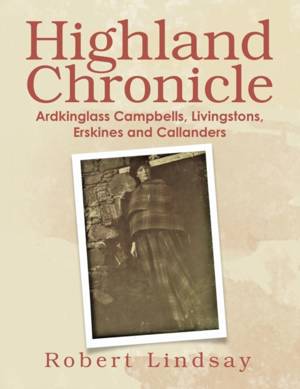
Door een staking bij bpost kan je online bestelling op dit moment iets langer onderweg zijn dan voorzien. Dringend iets nodig? Onze winkels ontvangen jou met open armen!
- Afhalen na 1 uur in een winkel met voorraad
- Gratis thuislevering in België vanaf € 30
- Ruim aanbod met 7 miljoen producten
Door een staking bij bpost kan je online bestelling op dit moment iets langer onderweg zijn dan voorzien. Dringend iets nodig? Onze winkels ontvangen jou met open armen!
- Afhalen na 1 uur in een winkel met voorraad
- Gratis thuislevering in België vanaf € 30
- Ruim aanbod met 7 miljoen producten
Zoeken
Highland Chronicle
Ardkinglass Campbells, Livingstons, Erskines, and Callanders
Robert Lindsay
Paperback | Engels
€ 32,45
+ 64 punten
Omschrijving
Robert Lindsay was rummaging in a house he inherited from his mother when he found a treasure trove of letters, photos, and personal effects that revealed some of the turbulent history of the Campbells of Ardkinglass. From 1396 on, they played a large role in the politics and social life of Scotland, and their dynastic ambitions expanded with their intermarriage with the Livingstons, Erskines, and Callanders. The Campbell lairds moved their chief residence from the shores of Loch Goil to Ardkinglass on Loch Fyne in the Western Highlands. The fourth laird was slain at Flodden Field with James IV, the sixth laird was appointed by James V to the Privy Council. The seventh and ninth lairds were indicted for murder but escaped death sentences. The fifteenth laird was a mercenary and fought under Frederick the Great. The short-lived sixteenth laird was the grandparent of Niall, the tenth Duke of Argyll. Neither Niall nor his gifted sister, Lady Elspeth Campbell, married. Elspeth was a fluent Gaelic speaker, played the bagpipes, and was the godmother of the author's mother. Explore the cultural and historical traditions of Scottish highlanders with this history of a colorful family that played a vital role in artistic, social, and political life.
Specificaties
Betrokkenen
- Auteur(s):
- Uitgeverij:
Inhoud
- Aantal bladzijden:
- 52
- Taal:
- Engels
Eigenschappen
- Productcode (EAN):
- 9781984502070
- Verschijningsdatum:
- 20/09/2018
- Uitvoering:
- Paperback
- Formaat:
- Trade paperback (VS)
- Afmetingen:
- 216 mm x 279 mm
- Gewicht:
- 190 g

Alleen bij Standaard Boekhandel
+ 64 punten op je klantenkaart van Standaard Boekhandel
Beoordelingen
We publiceren alleen reviews die voldoen aan de voorwaarden voor reviews. Bekijk onze voorwaarden voor reviews.











